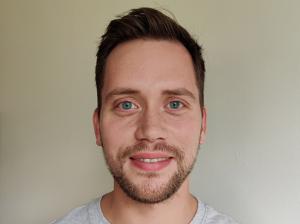Jan David Burger will defend his doctoral thesis in Physics on August 20. The defence will take place in the Aula at the Main building and starts at 10:00.
Live stream: https://livestream.com/hi/doktorsvornjandavidburger
Dissertation title: Stellar orbits in adiabatically and impulsively evolving dark matter dominated potentials
Opponents:
Dr. Justin Read, Professor at the University of Surrey, UK
Dr. Nicola Amorisco, Assistant Professor at the University of Durham, UK
Advisor: Dr. Jesús Zavala Franco, Associate Professor at the Faculty of Physical Sciences, University of Iceland
Doctoral committee:
Dr. Gunnlaugur Björnsson, Research Scientist at the Science Institute, University of Iceland
Dr. Miguel Ángel Sanchez-Conde, Talento Fellow at Universidad Autónoma de Madrid, Spain
Chair of Ceremony: Dr. Einar Örn Sveinbjörnsson, Professor and Head of the Faculty of Physical Sciences at the University of Iceland
Abstract:
In the ΛCDM concordance model cold and collision-less dark matter (CDM) accounts for about four fifths of the Universe’s total matter content, while visible baryonic matter makes up the final fifth. The ΛCDM model successfully describes how large scale structure forms from tiny density fluctuations in the early Universe, explaining the growth of dark matter (DM) overdensities and their eventual collapse into gravitation- ally self-bound objects called haloes which host the visible galaxies. The most enduring challenges to the ΛCDM paradigm arise on the scale of dwarf galaxies whose internal kinematics are seemingly at odds with the radial density profiles of the corresponding DM haloes predicted by CDM N-body simulations. While the evidence for such mis- matches remains controversial, several mechanisms have been proposed to reconcile the success of ΛCDM on large scales with these observations on smaller scales. Typ- ically, such mechanisms rely on non-gravitational effects to redistribute mass within, and thus alter the gravitational potential of, DM haloes. Depending on the specific mechanism, this mass redistribution occurs on timescales which are either longer or shorter than the typical dynamical timescales of stars in dwarf galaxies. In this thesis, I show that stars can be used as kinematic tracers to differentiate between adiabatically, i.e., slowly evolving, and impulsively, i.e., fast evolving potentials. In adiabatically evolving potentials, the actions of kinematic tracers are conserved. For moderately fast evolving spherical potentials, I show that the evolution of radial actions is perturbative and oscillatory. In this regime, the evolution of radial action distributions of tracers is well described by a diffusion equation. The evolution of a tracer’s radial action becomes non-perturbative as the rate at which the potential changes becomes large compared to the tracer’s radial period. An impulsive change in the gravitational potential, under which actions are not conserved, changes the energy of kinematic tracers by an amount that depends on their orbital phase. Using controlled N-body simulations, I demon- strate that as a consequence of the latter, shell-like signatures related to phase mixing emerge in the phase space of kinematic tracers whose orbits where characterized by similar integrals of motion prior to the change in the potential. Such orbital families are reasonably approximated by sets of stars with similar ages and metallicites. Ongoing phase mixing in orbital families within dwarf galaxies with slow-rising rotation curves would indicate the presence of strong and impulsive supernova feedback which may have converted the central cusps of the dwarfs’ host haloes into cores. Using a suite of hydrodynamic simulations of an isolated dwarf, I find that the kinematic properties of stars and gas differ in many ways between galaxies whose host haloes have an impulsive or an adiabatic core formation history. The complete absence of shell-like signatures of phase mixing in orbital families would be a strong indication that cores are likely formed adiabatically, for example through self-interactions between the DM particles.
About the doctoral candidate:
Jan Burger was born in Saarbrücken, Germany, on the 7th of February 1992. He obtained his B.Sc. degree in Physics at RWTH Aachen in 2014 and his M.Sc. degree in Physics at RWTH Aachen in 2016. He spent the first year of his Master studies at Universidad Autónoma de Madrid on an ERASMUS+ grant. In 2017, Jan moved to Iceland to start working as a PhD student in Astrophysics with Prof. Jesús Zavala Franco at the University of Iceland.

